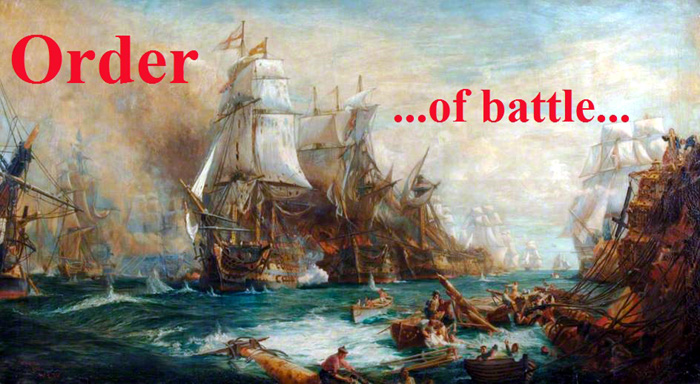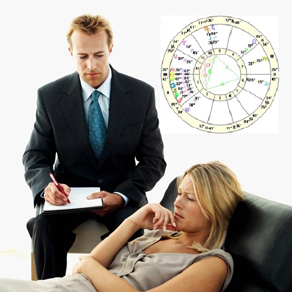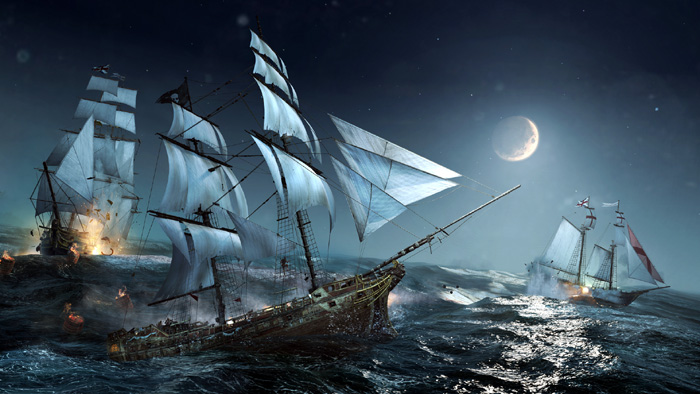
How you
see astrology itself determines how you engage a chart...
By John Townley, February 2015
When I began as an astrology student, sometime in 1968, my
first teacher Al H. Morrison used to hand out a valuable set of copied,
typed
sheets, entitled 15 Points of
Professional Astrology, by the early
twentieth-century astrologer Vivian Robson. It was, in effect, an
“order of battle” in
which an astrologer should approach a chart when analyzing it. What
comes
first, then next, what’s more or less import in weighting,
and so
on.
Formalized
“orders of battle” on land or sea have been
around since just slightly after organized conflict began, and they go
through
major sea
changes when the technology of conflict changes. The most important
recent ones
in modern history are likely the Napoleonic Wars (when Nelson won at
Trafalgar
by turning the rules on their heads with a
“line-ahead”
attack instead of the
long-prescribed “line
abreast”); WWII and blitzkrieg
(“lightning war”
where
armored cavalry, air strikes, and paratroopers spearhead sudden
overwhelming attacks);
and most recently guerilla or asymmetric warfare where a diffuse,
hard-to-find
smaller force can tie up or defeat a much larger traditional one. All
three
were driven by changes in technology and in the understanding of how to
use it.


Concepts of the
horoscope have changed from divine clockwork to inborn character
psychology and again are moving on...The approach
to reading a horoscope has gone through similar
shifts over the years, based on the prevailing philosophy of universal
structure
and
scientific measurement of what that structure might be. The first big
shift was
the result of Copernicus and heliocentricism, when astrology began to
be looked
at as more spiritual or symbolic than physical, as the original view of
a
directly connected earth-centered universe was set on its ear. As
individualism
and secularism stepped in to take an even greater toll, by the
twentieth
century the next step was to turn it into a pseudo-science somehow
connected
and perhaps backed by modern psychology and/or inner organic
proto-symbolism
(the “Jungian” approach) that depicted an inborn
template
of character.
Currently
tentatively underway is a shift toward a much more physical
and
environmental approach, in which only known principles such as gravity
and
electromagnetism are in play, within which individual events and
persons float
in mutual resonance with interacting cycles of force, rather like boats
upon
the sea. In less-nautical, more-geek parlance, that’s like
we’re individual
nodes oscillating in a matrix or network, where shared planetary
repetitions
(and thus degree areas) nudge and unite us in sets, within a broader
overall manifold.
Indeed, the physics of it is likely similar to harmonic
analysis in
music or light spectra, or orbital
mechanics, coming full circle
to the earliest thinkers in cosmology such as Pythagoras.
Critical Assumptions
Each of
these approaches entails many critical assumptions about
what’s important to look at that the subsequent ones later
eschew.
We no longer look at
the planets as messengers of God or clockwork Fate, so that
sort of
plug-in approach (which still lingers in textbooks today, particularly
in
things like elaborate rulerships, the final dispositor, and the like)
has been
largely abandoned. More recently, the later soft psychological approach
is
falling on
hard ground as psychology itself is turning out to be both more
genetically hard-wired
than previously thought at one end, and more environmentally in tune at
the
same time on the other. Further, the implications of chaos and
fractal-theory
concepts of the criticality and extrapolation of initial conditions
(the original
essence of the natal horoscope itself)
require
separating what is organically derived
from a
birth pattern from what is simply ancillary to it.

 A more environmental view of
astrology sees individuals as interacting nodes in a network,
selectively joined by transit waves.
A more environmental view of
astrology sees individuals as interacting nodes in a network,
selectively joined by transit waves.Here are
just four of multiple sea changes in concept that are now resetting our
"order of battle":
1. We can now toss out a lot of
accumulated detritus that simply doesn’t belong – the
first of which is anything that
precedes the natal instant itself,
since that
is the sole opening into the independent life envelope under
consideration. Already-in-play
things like genetics, sex,
race, economics, and preset exterior conditions are background,
albeit
important as the stage setting. So that means, for instance, that
where an
earlier astrologer might judge that a native with a fourth house
Jupiter is born to wealth (in actuality far more poor than rich are
born with
this each day, simply because there are more poor), it is still
reasonable to
say that there may be greater support from the home early on and
because of
repeated positively-reinforced cycle hits there, the native will have a
better
chance of winding up better-off eventually. That same cumulative
approach applies to every
planet in
every house, a sweeping readjustment of analysis. The basic concept is
no longer
God-given fate nor inborn trait, but all-surrounding environment and
its post-birth cyclical reinforcement of habit and expectation upon a
given
initial
pattern.
2. Another big
change, already partly-recognized by the
previous twentieth-century
view, is the signs of the outer
planets. These
distinguish whole sets of individuals, in some cases
whole generations in a
block,
not individuals themselves, except as they are aspected by faster, more
personal planets in a chart. For instance, Pluto in Leo was a major
component of
many Baby-Boomers, but also of the
immediately-previous generation that inspired
them, and
there was a distinct separate set of Boomers who had Pluto in Virgo,
and had a
very different group style. But a square of an inner planet to Pluto in
either sign
will still yield similarly troublesome results, regardless of sign, in
an individual.
That’s a
big change in approach as well, as it separates the scales of cycles
that can
repeat
multiply in a human’s life (and thus build, reinforce habits and
expectations)
from those that
only repeat over the longer lives of societies, nations, cultures --
and it also highlights where the two scales meet.

The natal horoscope doesn't come full-blown
from above anymore, but influences development within that grows with
time.
3. Yet another
changed priority will be how transits
to natal
are perceived. Both earlier astro-approaches looked at them as
highly
event-generating in and of themselves, whereas the new view paints
them more
as generating tides within a greater background, which increase
likelihood
of events entirely relative to opportunity,
proximity, and stability of specific circumstance.
And in this
view, a
rising tide doesn’t float all boats, just those a) not
beached
and b) in deep
enough water and in position to take advantage of the rise. A good look
at photos of
any
English harbor at high and low tides graphically illustrates
the effect. It
also looks at the general
state of transits
in the sky (current mutual aspects at large) as reinforcing
or conflicting wave forms setting up a variable sea
which affects all, but particularly relevant and proportionate to how
an individual is aligned
with them.
4. Further, these waves are
selective to the degree areas along which they resonate, and they
literally sort out and shepherd
individuals with like degrees into similar, recurring "families"
that often
have even greater strength than more traditionally-viewed genetic ties.
This effect has been given many literary names from "karmic"
relationships to Kurt Vonnegut's "karass" in Cat's Cradle. It
is what nudges into place the warp and woof of our relational
surroundings without and also gradually forms within us what we may
mistakenly call character itself. In fact, it is
so ineluctably pervasive you can even use it to rectify your birthtime.
These are
just a handful of the kind of resets the evolving
practitioner should consider to make analysis both simpler and more
effective,
in a shift that effortlessly dismisses the old free will vs.
determinism
debate
as a red herring born of scientific and philosophical myopia.
It’s a unifying approach
that will require a lot more inquiry to
steady it in order to resolve the multiple questions of
why astrology works that most astrologers today can't
answer,
but the theory is already there in principle, and it is up to the
individual practitioner to lay a hand on it and fine-tune its practical
applications.

Life and death play out upon the surface, but sea
and sky resonate regardlesss, propel the players and their patterns...
But as with
the literal “order of battle” on land and sea, evolution
and change is the only certainty. There we’ve moved from
simple
hand-to-hand
brutality, through standoff strikes and bombardments at long distance,
to coming robotic swarms in dizzying conflict with other automatic
devices,
right back
to the individual door-to-door level. We can only hope the
evolution of our understanding of the solar, lunar, and
planetary tidal forces around us
all
will overtake the pace of the skills of mutual destruction we so
singularly practice
while
sailing on life’s sky-born ocean...
P.S. So what would be a nice, textbook "15 Points"-type
listing of what to look at first, next, or discard for this new
approach? That will be the subject of the next, hands-on article on the
new environmental astrology...stay tuned!
Not
a
newsletter subscriber already? Subscribe
Free
Here!
And
every day, keep in touch with our Astrology In The News section...please
take a look! --
Breaking news from
around the globe, plus articles, reviews, it's all happening there,
changes daily..

